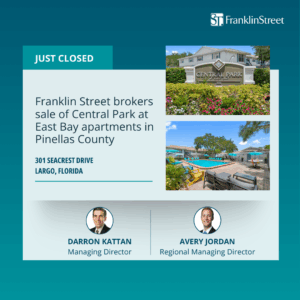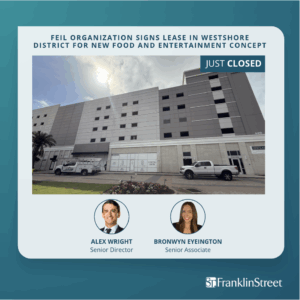By Casey Siggins, Director, Capital Advisory
Heading into 2022, most commercial real estate investors have regained confidence in the market and are eager to expand their portfolios with cash in hand. However, the types of assets they are targeting today look very different than they did before the pandemic. With record amounts of liquidity chasing opportunity in investment real estate, understanding and following the trends driving investment decisions by private equity will be critical at this stage of the market cycle.
Multifamily and industrial will continue to garner the most interest from the LP and joint venture (JV) private equity. The economic drivers behind multifamily and industrial are the strongest and investors simply forecast the best risk-adjusted returns in these property types as a result. However, more opportunistic investors are going to target the underserved property types such as big-box retail, office, lodging, student housing and seniors housing. While the risk profile of these assets is greater, the competition will be far less fierce, and investors will be able to demand much healthier returns on their investments.
Notably, there seems to be a shift occurring in regard to where limited partner (LP) equity is targeting its investment dollars. Historically, we have seen a primary focus on large metro markets, particularly in the Northeast and the West Coast (New York, Boston, Los Angeles, San Francisco). Today, we are seeing far more money chasing assets in the high-growth, Sun Belt regions of the country. Additionally, many investors appear to be shifting away from core gateway markets such as Miami, Atlanta and Dallas and into more secondary markets such as Nashville, Tenn., Austin, Texas, and Tampa/Orlando.
When it comes to situational appetite, we don’t believe that there will be a severe lack of liquidity available for any of the core categories. There will be demand for new development/opportunistic situations, repositioning and value-add plays, and core/core plus assets. There will also be many investors chasing redevelopment and asset conversion opportunities in particular markets.
In the matter of investor’s required returns, LP/JV equity is going to have a sliding scale dictated by property type, market dynamics, situational risk profile of the opportunity. For ground up development, most private equity is going to target a minimum of 20 percent internal rates of return (IRRs). For value-add plays, investors will be aiming to land mid-to-high teens range, and for core and core plus assets, investors will be requiring 12 percent to 15 percent IRRS. We anticipate required returns being compressed for popular asset types (multifamily & industrial) over the next 12 to 24 months, as supply will outweigh demand for LP/JV funding.
Heading into 2022, the major headwinds or concerns we are hearing about the most in conversations with LP equity investors across the spectrum are the challenges in supply chain management, labor costs and shortages, and inflation/rising interest rates. For investors focused on new development and/or value-add plays, the uncertainty in supply chains and labor markets is leading to volatility in their risk-return models on a weekly, if not daily, basis. Investors focused on stable, cash-flowing assets are concerned that a rising interest rate environment is going to lead to significant devaluation of property values in the short and mid-term. Of course, each property type has its own set of headwinds to consider as well.
Overall, 2022 should be a very healthy year for private equity placement in commercial real estate. Supply will remain near all-time highs and private investors will stand to benefit the greatest from it. In the highly-sought after markets discussed above, property valuations will continue to trend higher given the tailwinds provided by the favorable market fundamentals. While investors are not abandoning all caution in these markets, the overwhelming sentiment seems to be that potential returns outweigh the risk of continued investment.




